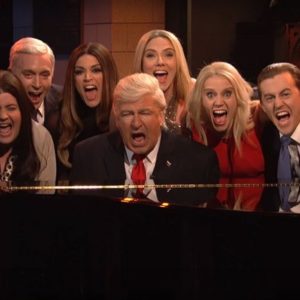Every year when the new season of “Saturday Night Live” premieres, an age-old debate pops up: which season of “SNL” is the best? Everyone has their favorite sketches and cast of characters. And there are, of course, those who say every year that “SNL” isn’t what it used to be — while they continue to watch the show every week. Regardless of where you fall on that spectrum, one thing is very clear. This past year of “SNL” has been perhaps more relevant and timely than any of the most recent seasons since 2008.
For younger folks, it may seem as if “SNL” has gotten more political, but politics has always been an integral part of “SNL” humor, dating back to its debut in 1975. Chevy Chase’s portrayal of then-President Gerald Ford — and President Ford’s subsequent appearance on the show — changed the way politicians interacted with entertainers and entertainment. For better or worse, “SNL” charted the path we are currently on.
But you don’t have to look that far back to see how “SNL” is influencing our politics. In 2008, Tina Fey won kudos for her spot-on impression of Sarah Palin. How many people actually believe that Palin said, “I can see Russia from my house”? Because she didn’t. Fey’s Palin did. Real Palin said: “You can actually see Russia from land here in Alaska.”
But it didn’t matter because it was just close enough to the truth that people believed she actually uttered those words. And it is now hard to see Will Ferrell act in anything and NOT think of his portrayal of President George W. Bush. Like Fey, he managed to play Bush so well that it was sometimes difficult to tell what was parody and what was fact. And, also like Fey, he had a wealth of material with which to work.
But it was this past season of “SNL” that provided some of the most interesting political humor in years. Alec Baldwin’s portrayal of Donald Trump, alongside Kate McKinnon’s Hillary Clinton, provided countless hours of laughs — sometimes uncomfortable, sometimes biting — but almost always funny.
But it wasn’t just the quality of the performances that made this year stand out. When you have the president of the United States tweeting about Baldwin’s performance the night before, and when Hillary Clinton shows up to play a character with “Hillary Clinton,” it’s hard to argue that the show isn’t shaping our culture and politics.
Lorne Michaels, the creator of “SNL,” is certainly taking advantage of the current environment. This summer, as political news was seemingly breaking by the hour and while “SNL” was on hiatus, he produced a series of “Weekend Update” primetime specials to take advantage of all the rich material emanating from the Trump White House and swampy Washington.
And lest anyone think that “SNL” only targets Republican administrations, you only have to look back to Phil Hartman and then Darryl Hammond and their portrayals of Bill Clinton. Hammond, especially, was able to play up Clinton’s best traits and his flaws for maximum comedic effect.
I will argue that “SNL” struggled for a while to find a good person to play Barack Obama — but once they did, let’s be honest: they struggled, though not for lack of trying. Obama didn’t exactly provide them with a great amount of material to work with. While that may be frustrating for a comedian, I certainly miss the days of no-drama Obama.
But what does any of this mean? Why should we care if “SNL” is still as relevant today as it was 42 years ago? I wouldn’t argue that this is the most pressing issue of our time, but, undeniably, “SNL” provides an opportunity to not take ourselves so seriously. To laugh (or cry, but mostly laugh) at the absurdity of our modern political landscape. To discover new comedic talents. And yes, to sometimes shine a light on a pressing political matter — with a dash of humor.

